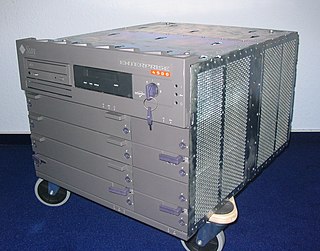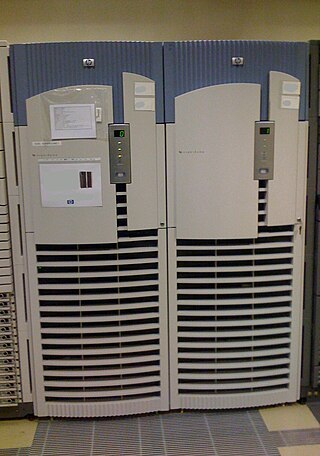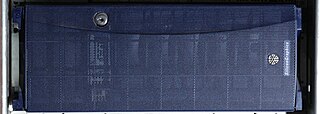
Itanium is a discontinued family of 64-bit Intel microprocessors that implement the Intel Itanium architecture. The Itanium architecture originated at Hewlett-Packard (HP), and was later jointly developed by HP and Intel. Launched in June 2001, Intel initially marketed the processors for enterprise servers and high-performance computing systems. In the concept phase, engineers said "we could run circles around PowerPC...we could kill the x86." Early predictions were that IA-64 would expand to the lower-end servers, supplanting Xeon, and eventually penetrate into the personal computers, eventually to supplant reduced instruction set computing (RISC) and complex instruction set computing (CISC) architectures for all general-purpose applications.

A motherboard is the main printed circuit board (PCB) in general-purpose computers and other expandable systems. It holds and allows communication between many of the crucial electronic components of a system, such as the central processing unit (CPU) and memory, and provides connectors for other peripherals. Unlike a backplane, a motherboard usually contains significant sub-systems, such as the central processor, the chipset's input/output and memory controllers, interface connectors, and other components integrated for general use.

HP-UX is Hewlett Packard Enterprise's proprietary implementation of the Unix operating system, based on Unix System V and first released in 1984. Current versions support HPE Integrity Servers, based on Intel's Itanium architecture.

Sun Enterprise is a range of UNIX server computers produced by Sun Microsystems from 1996 to 2001. The line was launched as the Sun Ultra Enterprise series; the Ultra prefix was dropped around 1998. These systems are based on the 64-bit UltraSPARC microprocessor architecture and related to the contemporary Ultra series of computer workstations. Like the Ultra series, they run Solaris. Various models, from single-processor entry-level servers to large high-end multiprocessor servers were produced. The Enterprise brand was phased out in favor of the Sun Fire model line from 2001 onwards.

HP 9000 is a line of workstation and server computer systems produced by the Hewlett-Packard (HP) Company. The native operating system for almost all HP 9000 systems is HP-UX, which is based on UNIX System V.

Altix is a line of server computers and supercomputers produced by Silicon Graphics, based on Intel processors. It succeeded the MIPS/IRIX-based Origin 3000 servers.
HPE Integrity Servers is a series of server computers produced by Hewlett Packard Enterprise since 2003, based on the Itanium processor. The Integrity brand name was inherited by HP from Tandem Computers via Compaq.
A hypervisor, also known as a virtual machine monitor (VMM) or virtualizer, is a type of computer software, firmware or hardware that creates and runs virtual machines. A computer on which a hypervisor runs one or more virtual machines is called a host machine, and each virtual machine is called a guest machine. The hypervisor presents the guest operating systems with a virtual operating platform and manages the execution of the guest operating systems. Unlike an emulator, the guest executes most instructions on the native hardware. Multiple instances of a variety of operating systems may share the virtualized hardware resources: for example, Linux, Windows, and macOS instances can all run on a single physical x86 machine. This contrasts with operating-system–level virtualization, where all instances must share a single kernel, though the guest operating systems can differ in user space, such as different Linux distributions with the same kernel.
Dynamic Logical Partitioning (DLPAR), is the capability of a logical partition (LPAR) to be reconfigured dynamically, without having to shut down the operating system that runs in the LPAR. DLPAR enables memory, CPU capacity, and I/O interfaces to be moved nondisruptively between LPARs within the same server.
The Apple Network Server (ANS) was a line of PowerPC-based server computers designed, manufactured and sold by Apple Computer, Inc. from February 1996 to April 1997. It was codenamed "Shiner" and originally consisted of two models, the Network Server 500/132 and the Network Server 700/150, which got a companion model, the Network Server 700/200 with a faster CPU in November 1996.

The IBM BladeCenter was IBM's blade server architecture, until it was replaced by Flex System in 2012. The x86 division was later sold to Lenovo in 2014.
Integrity Virtual Machines is a hypervisor from Hewlett Packard Enterprise for HPE Integrity Servers running HP-UX. It is part of HP's Virtual Server Environment suite, and is optimized for server use.
Logical Domains is the server virtualization and partitioning technology for SPARC V9 processors. It was first released by Sun Microsystems in April 2007. After the Oracle acquisition of Sun in January 2010, the product has been re-branded as Oracle VM Server for SPARC from version 2.0 onwards.
Skulltrail is an enthusiast gaming platform released by Intel on February 19, 2008. It is based on Intel's 5400 "Seaburg" workstation chipset. The primary difference between Skulltrail and Intel's current and past enthusiast chipsets is a dual CPU socket design that allows two processors to operate on the same motherboard. Therefore, Skulltrail can operate eight processing cores on one system. The platform supports two Core 2 Extreme QX9775 processors, which operate at 3.2 GHz.
The ES7000 is Unisys's x86/Windows, Linux and Solaris-based server product line. The "ES7000" brand has been used since 1999, although variants and models within the family support various processor and bus architectures. The server is marketed and positioned as a scale-up platform where scale-out becomes inefficient. Typically the ES7000 is utilized as a platform for homogeneous consolidation, large databases, Business Intelligence, Decision Support Systems, ERP, virtualization, as well as large Linux application hosting.

The HP Superdome is a high-end server computer designed and manufactured by Hewlett Packard Enterprise. The product's most recent version, "Superdome 2," was released in 2010 supporting 2 to 32 sockets and 4 TB of memory. The Superdome used PA-RISC processors when it debuted in 2000. Since 2002, a second version of the machine based on Itanium 2 processors has been marketed as the HP Integrity Superdome.

The SGI Origin 200, code named Speedo, was an entry-level server computer developed and manufactured by SGI, introduced in October 1996 to accompany their mid-range and high-end Origin 2000. It is based on the same architecture as the Origin 2000 but has an unrelated hardware implementation. At the time of introduction, these systems ran the IRIX 6.4, and later, the IRIX 6.5 operating systems. The Origin 200 was discontinued on 30 June 2002.
HP X-Terminals are a line of X terminals from Hewlett Packard introduced in the early- to mid-1990s, including the 700/X and 700/RX, Envizex and Entria, and the Envizex II and Entria II. They were often sold alongside PA-RISC-based HP 9000 Unix systems. The primary use case was connecting several graphical consoles to a single server or workstation to allow multiple users access the same (expensive) processing system from terminal systems. These X-Terminals all allowed high-resolution, color-graphics access to the main server from which they downloaded their operating system and necessary program files. All models featured limited expandability, in most cases additional I/O options for peripherals and memory for more programs or local storage. HP did not use its own PA-RISC platform for these systems, the first design used an Intel CISC processor, while all later systems used RISC platforms, first Intel i960 and later the popular MIPS.

LGA 1155, also called Socket H2, is a zero insertion force flip-chip land grid array (LGA) CPU socket designed by Intel for their CPUs based on the Sandy Bridge and Ivy Bridge microarchitectures.

The Dell blade server products are built around their M1000e enclosure that can hold their server blades, an embedded EqualLogic iSCSI storage area network and I/O modules including Ethernet, Fibre Channel and InfiniBand switches.











